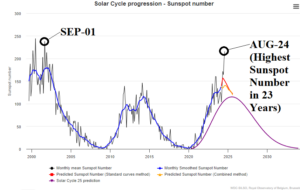Deep Tropics Starved for Mid-Atmosphere Moisture
09/06/2024, 8:48 am EDTFrancine Gains Organization and Intensity Heading to Louisiana Later Tomorrow
09/10/2024, 6:15 am EDT 
Fig. 1: Solar cycle progression sunspot number count according to NASA since 2000.
Discussion: In 2024 we’ve seen some unusual environmental occurrences observed far apart from what forecasters predicted. The most obvious example is the “historic” hurricane season forecast which to date is below normal. Another example is the over-forecast heat during the medium range on a consistent basis in the U.S., particularly the Great Plains. However, the largest surprise is the over-achieving sun. In August, the sunspot number (215) was the highest observed (Fig. 1) since September 2001 (23 years). The solar maxima of solar cycle 25 has arrived! NASA forecasts indicated solar maxima intensity would rival solar cycle 24 which was substantially weaker than the past 10 solar cycles. Speculation that a Dalton Minimum, a period of weak solar activity through 3 (11-year) solar cycles last observed during 1800-1830, was generating. The solar maxima for cycle 25 is just beginning and could continue to intensify as solar maxima can last up to 2 years. Once solar maxima peaks, onset of solar cycle 26 begins. Scientists require about 6 months of observations before the peak of solar maxima is known. According to NASA, solar activity during August lead to spectacular viewing of the Northern Lights. Pulses of vivid auroras have occurred for several months reaching as far south as Houston on May 10th. Viewing of the Northern Lights reached northwest Texas in early August. The daily sunspot number reached 337 on August 8th according to NASA, the highest daily observation since March 2001. NASA reminds us that “during this period of an unusually active sun, more solar flares and coronal mass ejections (CME’s) carry large expulsions of plasma and magnetic field from the Sun’s corona that can cause intense geomagnetic storms”.
